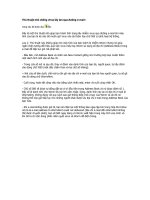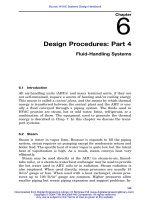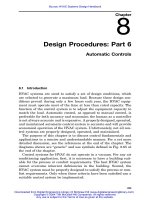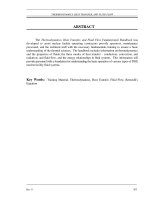Antivirus hackers handbook
Bạn đang xem bản rút gọn của tài liệu. Xem và tải ngay bản đầy đủ của tài liệu tại đây (5.62 MB, 384 trang )
The Antivirus Hacker’s
Handbook
ffirs.indd 08:14:22:AM 08/13/2015
Page i
The Antivirus Hacker’s
Handbook
Joxean Koret
Elias Bachaalany
ffirs.indd 08:14:22:AM 08/13/2015
Page iii
The Antivirus Hacker’s Handbook
Published by
John Wiley & Sons, Inc.
10475 Crosspoint Boulevard
Indianapolis, IN 46256
www.wiley.com
Copyright © 2015 by John Wiley & Sons, Inc., Indianapolis, Indiana
Published simultaneously in Canada
ISBN: 978-1-119-02875-8
ISBN: 978-1-119-02876-5 (ebk)
ISBN: 978-1-119-02878-9 (ebk)
Manufactured in the United States of America
10 9 8 7 6 5 4 3 2 1
No part of this publication may be reproduced, stored in a retrieval system or transmitted in any form or
by any means, electronic, mechanical, photocopying, recording, scanning or otherwise, except as permitted
under Sections 107 or 108 of the 1976 United States Copyright Act, without either the prior written permission of the Publisher, or authorization through payment of the appropriate per-copy fee to the Copyright
Clearance Center, 222 Rosewood Drive, Danvers, MA 01923, (978) 750-8400, fax (978) 646-8600. Requests to
the Publisher for permission should be addressed to the Permissions Department, John Wiley & Sons, Inc.,
111 River Street, Hoboken, NJ 07030, (201) 748-6011, fax (201) 748-6008, or online at ey
.com/go/permissions.
Limit of Liability/Disclaimer of Warranty: The publisher and the author make no representations or warranties with respect to the accuracy or completeness of the contents of this work and specifically disclaim all
warranties, including without limitation warranties of fitness for a particular purpose. No warranty may be
created or extended by sales or promotional materials. The advice and strategies contained herein may not
be suitable for every situation. This work is sold with the understanding that the publisher is not engaged in
rendering legal, accounting, or other professional services. If professional assistance is required, the services
of a competent professional person should be sought. Neither the publisher nor the author shall be liable for
damages arising herefrom. The fact that an organization or Web site is referred to in this work as a citation
and/or a potential source of further information does not mean that the author or the publisher endorses
the information the organization or website may provide or recommendations it may make. Further, readers
should be aware that Internet websites listed in this work may have changed or disappeared between when
this work was written and when it is read.
For general information on our other products and services please contact our Customer Care Department
within the United States at (877) 762-2974, outside the United States at (317) 572-3993 or fax (317) 572-4002.
Wiley publishes in a variety of print and electronic formats and by print-on-demand. Some material included
with standard print versions of this book may not be included in e-books or in print-on-demand. If this book
refers to media such as a CD or DVD that is not included in the version you purchased, you may download
this material at . For more information about Wiley products, visit
www.wiley.com.
Library of Congress Control Number: 2015945503
Trademarks: Wiley and the Wiley logo are trademarks or registered trademarks of John Wiley & Sons, Inc.
and/or its affiliates, in the United States and other countries, and may not be used without written permission.
All other trademarks are the property of their respective owners. John Wiley & Sons, Inc. is not associated
with any product or vendor mentioned in this book.
ffirs.indd 08:14:22:AM 08/13/2015
Page iv
About the Authors
Joxean Koret has been working for the past +15 years in many different computing areas. He started as a database software developer and DBA, working
with a number of different RDBMSs. Afterward he got interested in reverseengineering and applied this knowledge to the DBs he was working with. He
has discovered dozens of vulnerabilities in products from the major database
vendors, especially in Oracle software. He also worked in other security areas,
such as developing IDA Pro at Hex-Rays or doing malware analysis and antimalware software development for an antivirus company, knowledge that was
applied afterward to reverse-engineer and break over 14 AV products in roughly
one year. He is currently a security researcher in Coseinc.
Elias Bachaalany has been a computer programmer, a reverse-engineer, an occasional reverse-engineering trainer, and a technical writer for the past 14 years.
Elias has also co-authored the book Practical Reverse Engineering, published by
Wiley (ISBN: 978-111-8-78731-1). He has worked with various technologies and
programming languages including writing scripts, doing web development,
working with database design and programming, writing Windows device
drivers and low-level code such as boot loaders or minimal operating systems,
writing managed code, assessing software protections, and writing reverseengineering and desktop security tools. Elias has also presented twice at REcon
Montreal (2012 and 2013).
While working for Hex-Rays SA in Belgium, Elias helped improve and add
new features to IDA Pro. During that period, he authored various technical blog
posts, provided IDA Pro training, developed various debugger plug-ins, amped
up IDA Pro’s scripting facilities, and contributed to the IDAPython project. Elias
currently works at Microsoft.
v
ffirs.indd 08:14:22:AM 08/13/2015
Page v
Credits
Project Editor
Sydney Argenta
Technical Editor
Daniel Pistelli
Production Editor
Saleem Hameed Sulthan
Copy Editor
Marylouise Wiack
Manager of Content Development
& Assembly
Mary Beth Wakefield
Professional Technology &
Strategy Director
Barry Pruett
Business Manager
Amy Knies
Associate Publisher
Jim Minatel
Project Coordinator, Cover
Brent Savage
Proofreader
Nicole Hirschman
Production Manager
Kathleen Wisor
Indexer
Nancy Guenther
Marketing Director
David Mayhew
Cover Designer
Wiley
Marketing Manager
Carrie Sherrill
Cover Image
Wiley; Shield © iStock.com/DSGpro
vii
ffirs.indd 08:14:22:AM 08/13/2015
Page vii
Acknowledgments
I would like to acknowledge Mario Ballano, Ruben Santamarta, and Victor
Manual Alvarez, as well as all my friends who helped me write this book, shared
their opinions and criticisms, and discussed ideas. I am most thankful to my
girlfriend for her understanding and support during the time that I spent on
this book. Many thanks to Elias Bachaalany; without his help, this book would
not have been possible. Also, special thanks to everyone at Wiley; it has been
a great pleasure to work with you on this book. I am grateful for the help and
support of Daniel Pistelli, Carol Long, Sydney Argenta, Nicole Hirschman,
and Marylouise Wiack.
ix
ffirs.indd 08:14:22:AM 08/13/2015
Page ix
Contents at a Glance
Introduction
xix
Part I
Antivirus Basics
1
Chapter 1
Introduction to Antivirus Software
3
Chapter 2
Reverse-Engineering the Core
15
Chapter 3
The Plug-ins System
57
Chapter 4
Understanding Antivirus Signatures
77
Chapter 5
The Update System
87
Part II
Antivirus Software Evasion
103
Chapter 6
Antivirus Software Evasion
105
Chapter 7
Evading Signatures
117
Chapter 8
Evading Scanners
133
Chapter 9
Evading Heuristic Engines
165
Chapter 10
Identifying the Attack Surface
183
Chapter 11
Denial of Service
207
Part III
Analysis and Exploitation
217
Chapter 12
Static Analysis
219
Chapter 13
Dynamic Analysis
235
Chapter 14
Local Exploitation
269
Chapter 15
Remote Exploitation
297
xi
ffirs.indd 08:14:22:AM 08/13/2015
Page xi
xii
Contents at a Glance
Part IV
Current Trends and Recommendations
321
Chapter 16
Current Trends in Antivirus Protection
323
Chapter 17
Recommendations and the Possible Future
331
Index
ffirs.indd 08:14:22:AM 08/13/2015
347
Page xii
Contents
Introduction
xix
Part I
Antivirus Basics
1
Chapter 1
Introduction to Antivirus Software
What Is Antivirus Software?
Antivirus Software: Past and Present
Antivirus Scanners, Kernels, and Products
Typical Misconceptions about Antivirus Software
Antivirus Features
3
3
4
5
6
7
Basic Features
Making Use of Native Languages
Scanners
Signatures
Compressors and Archives
Unpackers
Emulators
Miscellaneous File Formats
Advanced Features
Packet Filters and Firewalls
Self-Protection
Anti-Exploiting
Chapter 2
7
7
8
8
9
10
10
11
11
11
12
12
Summary
13
Reverse-Engineering the Core
Reverse-Engineering Tools
15
15
Command-Line Tools versus GUI Tools
Debugging Symbols
Tricks for Retrieving Debugging Symbols
16
17
17
Debugging Tricks
20
xiii
ftoc.indd
05:49:16:PM 08/10/2015
Page xiii
xiv
Contents
Backdoors and Configuration Settings
Kernel Debugging
Debugging User-Mode Processes with a Kernel-Mode
Debugger
Analyzing AV Software with Command-Line Tools
Chapter 3
21
23
25
27
Porting the Core
A Practical Example: Writing Basic Python Bindings
for Avast for Linux
28
A Brief Look at Avast for Linux
Writing Simple Python Bindings for Avast for Linux
The Final Version of the Python Bindings
29
32
37
29
A Practical Example: Writing Native C/C++ Tools for Comodo
Antivirus for Linux
Other Components Loaded by the Kernel
Summary
37
55
56
The Plug-ins System
Understanding How Plug-ins Are Loaded
57
58
A Full-Featured Linker in Antivirus Software
58
Understanding Dynamic Loading
59
Advantages and Disadvantages of the Approaches for Packaging
Plug-ins
60
Types of Plug-ins
Scanners and Generic Routines
File Format and Protocol Support
Heuristics
Bayesian Networks
Bloom Filters
Weights-Based Heuristics
Chapter 4
63
64
65
66
67
68
Some Advanced Plug-ins
69
Memory Scanners
Non-native Code
Scripting Languages
Emulators
69
70
72
73
Summary
74
Understanding Antivirus Signatures
Typical Signatures
77
77
Byte-Streams
Checksums
Custom Checksums
Cryptographic Hashes
Advanced Signatures
Fuzzy Hashing
Graph-Based Hashes for Executable Files
Summary
ftoc.indd
62
05:49:16:PM 08/10/2015
78
78
79
80
80
81
83
85
Page xiv
Contents
Chapter 5
The Update System
Understanding the Update Protocols
87
88
Support for SSL/TLS
Verifying the Update Files
89
91
Dissecting an Update Protocol
When Protection Is Done Wrong
Summary
92
100
101
Part II
Antivirus Software Evasion
103
Chapter 6
Antivirus Software Evasion
Who Uses Antivirus Evasion Techniques?
Discovering Where and How Malware Is Detected
105
106
107
Old Tricks for Determining Where Malware Is
Detected: Divide and Conquer
Evading a Simple Signature-Based Detection with the
Divide and Conquer Trick
Binary Instrumentation and Taint Analysis
Chapter 7
108
113
Summary
114
Evading Signatures
File Formats: Corner Cases and Undocumented Cases
Evading a Real Signature
Evasion Tips and Tricks for Specific File Formats
117
118
118
124
PE Files
JavaScript
String Encoding
Executing Code on the Fly
Hiding the Logic: Opaque Predicates and Junk Code
Chapter 8
107
124
126
127
128
128
129
Summary
131
Evading Scanners
Generic Evasion Tips and Tricks
133
133
Fingerprinting Emulators
Advanced Evasion Tricks
Taking Advantage of File Format Weaknesses
Using Anti-emulation Techniques
Using Anti-disassembling Techniques
Disrupting Code Analyzers through Anti-analysis
More Anti-Anti-Anti…
Causing File Format Confusion
Automating Evasion of Scanners
134
136
136
137
142
144
147
148
148
Initial Steps
Installing ClamAV
Installing Avast
Installing AVG
149
150
150
151
ftoc.indd
05:49:16:PM 08/10/2015
Page xv
xv
xvi
Contents
Installing F-Prot
Installing Comodo
Installing Zoner Antivirus
MultiAV Configuration
peCloak
Writing the Final Tool
Chapter 9
Summary
162
Evading Heuristic Engines
Heuristic Engine Types
165
165
Static Heuristic Engines
Bypassing a Simplistic Static Heuristic Engine
Dynamic Heuristic Engines
Userland Hooks
Bypassing a Userland HIPS
Kernel-Land Hooks
Chapter 10
180
Identifying the Attack Surface
Understanding the Local Attack Surface
183
185
Incorrect Access Control Lists
Kernel-Level Vulnerabilities
Exotic Bugs
Exploiting SUID and SGID Binaries on Unix-Based Platforms
ASLR and DEP Status for Programs and Binaries
Exploiting Incorrect Privileges on Windows Objects
Exploiting Logical Flaws
Understanding the Remote Attack Surface
File Parsers
Generic Detection and File Disinfection Code
Network Services, Administration Panels, and Consoles
Firewalls, Intrusion Detection Systems, and Their Parsers
Update Services
Browser Plug-ins
Security Enhanced Software
185
186
186
187
187
188
189
190
193
196
197
198
199
199
200
201
201
202
Summary
203
Denial of Service
Local Denial-of-Service Attacks
207
208
Compression Bombs
Creating a Simple Compression Bomb
Bugs in File Format Parsers
Attacks against Kernel Drivers
Remote Denial-of-Service Attacks
Compression Bombs
Bugs in File Format Parsers
Summary
ftoc.indd
166
166
173
173
176
178
Summary
Finding Weaknesses in File and Directory Privileges
Escalation of Privileges
Incorrect Privileges in Files and Folders
Chapter 11
152
153
154
154
158
160
05:49:16:PM 08/10/2015
208
209
212
213
214
214
215
215
Page xvi
Contents
Part III
Analysis and Exploitation
217
Chapter 12
Static Analysis
Performing a Manual Binary Audit
219
219
File Format Parsers
Remote Services
Chapter 13
220
228
Summary
233
Dynamic Analysis
Fuzzing
235
235
What Is a Fuzzer?
Simple Fuzzing
Automating Fuzzing of Antivirus Products
Using Command-Line Tools
Porting Antivirus Kernels to Unix
Fuzzing with Wine
Problems, Problems, and More Problems
Finding Good Templates
Finding Template Files
Maximizing Code Coverage
Blind Code Coverage Fuzzer
Using Blind Code Coverage Fuzzer
Nightmare, the Fuzzing Suite
Configuring Nightmare
Finding Samples
Configuring and Running the Fuzzer
236
237
239
240
243
244
247
248
250
252
253
254
259
260
262
262
Summary
266
Chapter 14
Local Exploitation
Exploiting Backdoors and Hidden Features
Finding Invalid Privileges, Permissions, and ACLs
Searching Kernel-Land for Hidden Features
More Logical Kernel Vulnerabilities
Summary
269
270
274
279
285
295
Chapter 15
Remote Exploitation
Implementing Client-Side Exploitation
297
297
Exploiting Weakness in Sandboxing
Exploiting ASLR, DEP, and RWX Pages at Fixed Addresses
Writing Complex Payloads
Taking Advantage of Emulators
Exploiting Archive Files
Finding Weaknesses in Intel x86, AMD x86_64, and ARM
Emulators
Using JavaScript, VBScript, or ActionScript
Determining What an Antivirus Supports
Launching the Final Payload
Exploiting the Update Services
Writing an Exploit for an Update Service
Server-Side Exploitation
297
298
300
301
302
303
303
304
306
307
308
317
ftoc.indd
05:49:16:PM 08/10/2015
Page xvii
xvii
xviii
Contents
Differences between Client-Side and Server-Side Exploitation
Exploiting ASLR, DEP, and RWX Pages at Fixed Addresses
317
318
Summary
318
Part IV
Current Trends and Recommendations
321
Chapter 16
Current Trends in Antivirus Protection
Matching the Attack Technique with the Target
323
324
The Diversity of Antivirus Products
Zero-Day Bugs
Patched Bugs
Targeting Home Users
Targeting Small to Medium-Sized Companies
Targeting Governments and Big Companies
The Targets of Governments
Chapter 17
326
327
Summary
328
Recommendations and the Possible Future
Recommendations for Users of Antivirus Products
331
331
Blind Trust Is a Mistake
Isolating Machines Improves Protection
Auditing Security Products
332
337
338
Recommendations for Antivirus Vendors
338
Engineering Is Different from Security
Exploiting Antivirus Software Is Trivial
Perform Audits
Fuzzing
Use Privileges Safely
Reduce Dangerous Code in Parsers
Improve the Safety of Update Services and Protocols
Remove or Disable Old Code
Summary
339
339
340
340
341
342
342
343
344
Index
ftoc.indd
324
324
325
325
326
347
05:49:16:PM 08/10/2015
Page xviii
Introduction
Welcome to The Antivirus Hacker’s Handbook. With this book, you can increase
your knowledge about antivirus products and reverse-engineering in general;
while the reverse-engineering techniques and tools discussed in this book are
applied to antivirus software, they can also be used with any other software
products. Security researchers, penetration testers, and other information security professionals can benefit from this book. Antivirus developers will benefit
as well because they will learn more about how antivirus products are analyzed,
how they can be broken into parts, and how to prevent it from being broken or
make it harder to break.
I want to stress that although this book is, naturally, focused on antivirus products,
it also contains practical examples that show how to apply reverse-engineering,
vulnerability discovery, and exploitation techniques to real-world applications.
Overview of the Book and Technology
This book is designed for individuals who need to better understand the functionality of antivirus products, regardless of which side of the fence they are on:
offensive or defensive. Its objective is to help you learn when and how specific
techniques and tools should be used and what specific parts of antivirus products you should focus on, based on the specific tasks you want to accomplish.
This book is for you if any of the following statements are true:
■
You want to learn more about the security of antivirus products.
■
You want to learn more about reverse-engineering, perhaps with the aim
of reverse-engineering antivirus products.
■
You want to bypass antivirus software.
■
You want to break antivirus software into pieces.
xix
flast.indd
05:52:32:PM 08/07/2015
Page xix
xx
Introduction
■
You want to write exploits for antivirus software.
■
You want to evaluate antivirus products.
■
You want to increase the overall security of your own antivirus products,
or you want to know how to write security-aware code that will deal with
hostile code.
■
You love to tinker with code, or you want to expand your skills and
knowledge in the information security field.
How This Book Is Organized
The contents of this book are structured as follows:
■
Chapter 1, “Introduction to Antivirus Software”—Guides you through
the history of antivirus software to the present, and discusses the most
typical features available in antivirus products, as well as some less common ones.
■
Chapter 2, “Reverse-Engineering the Core”—Describes how to reverseengineer antivirus software, with tricks that can be used to debug the
software or disable its self-protection mechanisms. This chapter also
discusses how to apply this knowledge to create Python bindings for
Avast for Linux, as well as a native C/C++ tool and unofficial SDK for
the Comodo for Linux antivirus.
■
Chapter 3, “The Plug-ins System”—Discusses how antivirus products
use plug-ins, how they are loaded, and how they are distributed, as well
as the purpose of antivirus plug-ins.
■
Chapter 4, “Understanding Antivirus Signatures”—Explores the most
typical signature types used in antivirus products, as well as some more
advanced ones.
■
Chapter 5, “The Update System”—Describes how antivirus software is
updated, how the update systems are developed, and how update protocols work. This chapter concludes by showing a practical example of
how to reverse-engineer an easy update protocol.
■
Chapter 6, “Antivirus Software Evasion”—Gives a basic overview of
how to bypass antivirus software, so that files can evade detection. Some
general tricks are discussed, as well as techniques that should be avoided.
■
Chapter 7, “Evading Signatures”—Continues where Chapter 4 left off
and explores how to bypass various kinds of signatures.
■
Chapter 8, “Evading Scanners”—Continues the discussion of how to
bypass antivirus products, this time focusing on scanners. This chapter
looks at how to bypass some static heuristic engines, anti-disassembling,
anti-emulation, and other “anti-” tricks, as well as how to write an automatic tool for portable executable file format evasion of antivirus scanners.
flast.indd
05:52:32:PM 08/07/2015
Page xx
Introduction
■
Chapter 9, “Evading Heuristic Engines”—Finishes the discussion on
evasion by showing how to bypass both static and dynamic heuristic
engines implemented by antivirus products.
■
Chapter 10, “Identifying the Attack Surface”—Introduces techniques
used to attack antivirus products. This chapter will guide you through the
process of identifying both the local and remote attack surfaces exposed
by antivirus software.
■
Chapter 11, “Denial of Service”—Starts with a discussion about performing denial-of-service attacks against antivirus software. This chapter discusses how such attacks can be launched against antivirus products both
locally and remotely by exploiting their vulnerabilities and weaknesses.
■
Chapter 12, “Static Analysis”—Guides you through the process of statically auditing antivirus software to discover vulnerabilities, including
real-world vulnerabilities.
■
Chapter 13, “Dynamic Analysis”—Continues with the discussion of
finding vulnerabilities in antivirus products, but this time using dynamic
analysis techniques. This chapter looks specifically at fuzzing, the most
popular technique used to discover vulnerabilities today. Throughout
this chapter, you will learn how to set up a distributed fuzzer with central
administration to automatically discover bugs in antivirus products and
be able to analyze them.
■
Chapter 14, “Local Exploitation”—Guides you through the process of
exploiting local vulnerabilities while putting special emphasis on logical
flaws, backdoors, and unexpected usages of kernel-exposed functionality.
■
Chapter 15, “Remote Exploitation”—Discusses how to write exploits
for memory corruption issues by taking advantage of typical mistakes in
antivirus products. This chapter also shows how to target update services
and shows a full exploit for one update service protocol.
■
Chapter 16, “Current Trends in Antivirus Protection”—Discusses which
antivirus product users can be targeted by actors that use flaws in antivirus software, and which users are unlikely to be targeted with such
techniques. This chapter also briefly discusses the dark world in which
such bugs are developed.
■
Chapter 17, “Recommendations and the Possible Future”—Concludes
this book by making some recommendations to both antivirus users and
antivirus vendors, and discusses which strategies can be adopted in the
future by antivirus products.
Who Should Read This Book
This book is designed for individual developers and reverse-engineers with
intermediate skills, although the seasoned reverse-engineer will also benefit
flast.indd
05:52:32:PM 08/07/2015
Page xxi
xxi
xxii
Introduction
from the techniques discussed here. If you are an antivirus engineer or a malware reverse-engineer, this book will help you to understand how attackers
will try to exploit your software. It will also describe how to avoid undesirable
situations, such as exploits for your antivirus product being used in targeted
attacks against the users you are supposed to protect.
More advanced individuals can use specific chapters to gain additional skills
and knowledge. As an example, if you want to learn more about writing local
or remote exploits for antivirus products, proceed to Part III, “Analysis and
Exploitation,” where you will be guided through almost the entire process of
discovering an attack surface, finding vulnerabilities, and exploiting them. If you
are interested in antivirus evasion, then Part II, “Antivirus Software Evasion,”
is for you. So, whereas some readers may want to read the book from start to
finish, there is nothing to prevent you from moving around as needed.
Tools You Will Need
Your desire to learn is the most important thing you have as you start to read
this book. Although I try to use open-source “free” software, this is not always
possible. For example, I used the commercial tool IDA in a lot of cases; because
antivirus programs are, with only one exception, closed-source commercial
products, you need to use a reverse-engineering tool, and IDA is the de facto one.
Other tools that you will need include compilers, interpreters (such as Python),
and some tools that are not open source but that can be freely downloaded, such
as the Sysinternals tools.
What’s on the Wiley Website
To make it as easy as possible for you to get started, some of the basic tools you
will need are available on the Wiley website, which has been set up for this
book at www.wiley.com/go/antivirushackershandbook.
Summary (From Here, Up Next, and So On)
The Antivirus Hacker’s Handbook is designed to help readers become aware of
what antivirus products are, what they are not, and what to expect from them;
this information is not usually available to the public. Rather than discussing
how antivirus products work in general, it shows real bugs, exploits, and techniques for real-world products that you may be using right now and provides
real-world techniques for evasion, vulnerability discovery, and exploitation.
Learning how to break antivirus software not only helps attackers but also helps
you to understand how antivirus products can be enhanced and how antivirus
users can best protect themselves.
flast.indd
05:52:32:PM 08/07/2015
Page xxii
Par t
I
Antivirus Basics
In This Part
Chapter 1: Introduction to Antivirus Software
Chapter 2: Reverse-Engineering the Core
Chapter 3: The Plug-ins System
Chapter 4: Understanding Antivirus Signatures
Chapter 5: The Update System
c01.indd
02:36:42:PM 07/29/2015
Page 1









